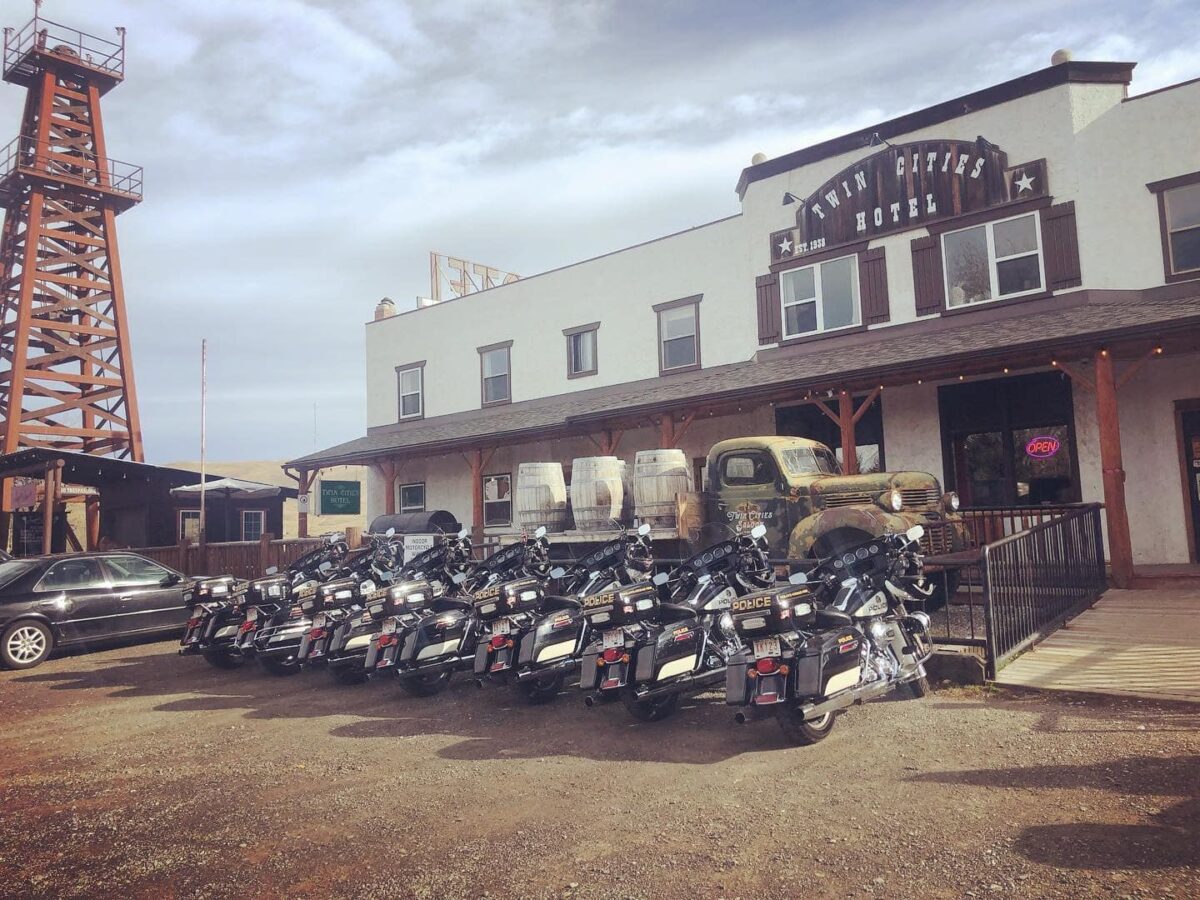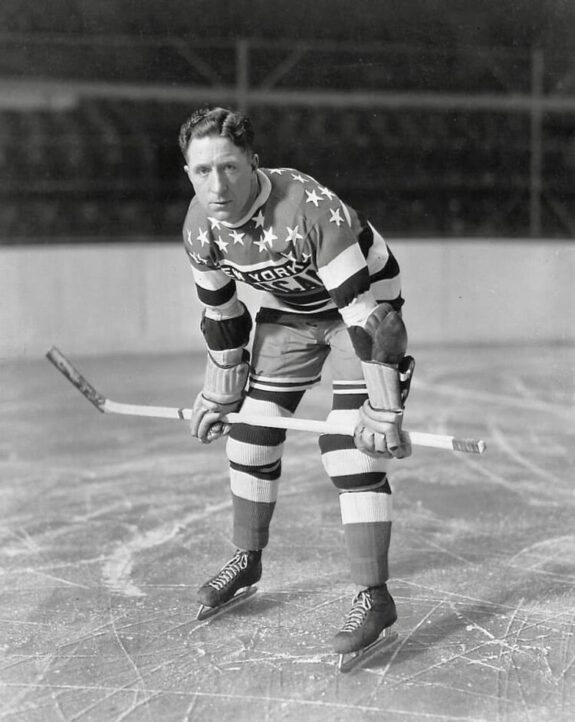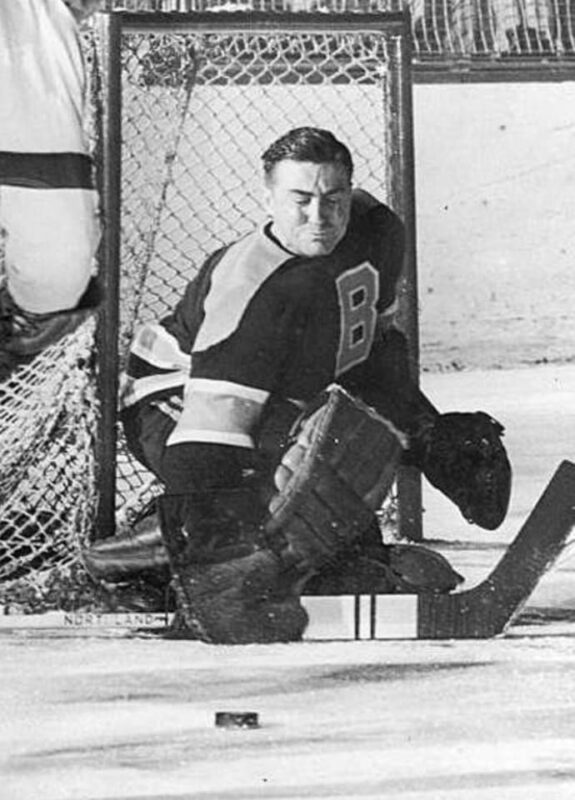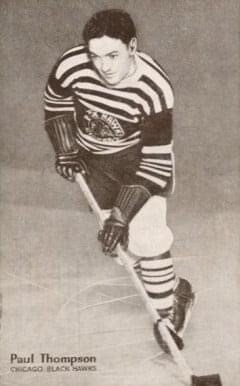The Twin Cities Saloon in Longview, Alberta stands like a sentinel along the Cowboy Trail on the wind-swept prairie an hour outside of “Cowtown,” as Calgary is affectionately known. The saloon has been a part of Wild Rose Country lore since 1938 – a labour of love by three star NHLers who played in the 1920s, and 30s – a time when hockey was a game played by men of iron will and murderous determination.
The Saloon – Pride of Longview
The Twin Cities Saloon is now owned by long-time area resident Chris Goss. He speaks proudly of his saloon and continues to honour its roots in NHL hockey with plaques hanging on the walls to memorialize the three NHLers who built her.
The saloon is as authentic as they come with swinging doors at the entrance, a long bar from which the barkeep pours whiskey and serves up cold beer, and seven rooms upstairs renting for $75 a night. Each comes with a bed with the original headboard and a wash basin. Guests share a common bathroom.
The saloon serves great food and ice-cold local brews. If you get there, make sure you order the Longview Burger – one of the finest in all of southern Alberta and made with top-grade Alberta beef. When you’re finished you can take in the live entertainment served up to patrons three nights per week or try your luck at slots, pool, and pinball.

The saloon is set against the stunning backdrop of the Canadian Rockies and boasts a real oil-drilling derrick towering over the hotel and its expansive outdoor deck. It’s become a summertime destination for recreational bikers from across southern Alberta and beyond.
You could be forgiven for expecting Clint Eastwood to swagger into the saloon. In fact, his Academy Award winning 1991 Western, Unforgiven, was filmed in the Longview area. So too was the 2003 Western, Monty Walsh starring Tom Selleck, Isabella Rosselini and Keith Carradine.

Canadian country music icon Ian Tyson lived in Longview and often came into the saloon for a cold one. Saloon patrons are left to wonder what it would have been like to hear Tyson play “Four Strong Winds” – that wistful ode to Alberta that’s sure to bring a tear to the eye of any Canadian.
Red Dutton – A Story of Iron Will
The Twin Cites saloon has stood the test of time for 86 years and through its walls runs the character of the three NHLers who built her – Norman Alexander “Red” Dutton, Cecil “Tiny” Thompson and his brother Paul. All of them led extraordinary lives, but perhaps none more so than Dutton – a character in real life tougher than any of the fictional Duttons in the hit Paramount Network series, Yellowstone.
Related: Calgary Flames’ First Nation and Metis Connections
Dutton was 17 when he enlisted in the Canadian Expeditionary Force in World War I. Serving with the legendary Princess Patricia’s Canadian Light Infantry (nicknamed “The Pats” and often “The Vicious Patricias”) Dutton fought at the battle of Vimy Ridge in northern France in April, 1917. Driving the German army out of their position on that ridge took the lives of 3,598 young Canadians and wounded 7,000 more – all in just three days. Dutton was one of the wounded.
Shrapnel from an exploding German munition tore apart his right leg and hip. He lay in a chalk pit for more than three days before being treated. Army medics pushed him to let them amputate, but Dutton refused. It took him 18 months to recover the use of his leg and when he did, he played hockey constantly in his native Manitoba. In Winnipeg, he played in seven different leagues, sometimes twice a night.
Dutton went on to play for the NHL’s Montreal Maroons and New York Americans. He was a rugged defenceman who set several NHL records for penalty minutes. Yet, he was much more than the sum of the time he spent in the sin bin.
After the Maroons sent him packing to the Big Apple, he went on to become the New York Americans’ coach – only the second player-coach in NHL history. In 1936 he took over the management of the team and built them into the New York Rangers’ arch cross-town rival.

He began to plan the construction of an arena in Brooklyn to house the Americans but those plans were shelved at the start of the 1942-43 season after the United States entered World War II. The league suspended the operations of the Americans but gave assurances to Dutton, by now owner of the team, that the franchise would again see action on the Hudson River following the war.
In 1943, the NHL asked Dutton to take over as league president following the sudden death of Frank Calder, the league’s first president. He stayed in that post until 1946 when he resigned in a fit of anger on learning that the NHL had decided to cancel the Americans’ franchise, leaving New York all to the Rangers. However, he stayed on until he could convince the league to hire Clarence Campbell as his replacement – a job the North-West Territories native held until his death in 1984.
Dutton went on to build a major Western Canadian construction company that in 1960 built McMahon Stadium where the Canadian Football League’s Calgary Stampeders still play. It also served as the Olympic Stadium for the 1988 Winter Olympics and hosted the 2011 NHL Heritage Classic between the Calgary Flames and the Montreal Canadiens.
Dutton was inducted into the Hockey Hall of Fame in 1958 and received the Order of Canada in 1981. In 1993 he was posthumously awarded the NHL’s Lester Patrick Trophy for his contributions to hockey in the United States.
Dutton’s life was one of great triumph, but also of tragedy. He and his wife Mory had three sons and a daughter. All three of his boys fought in World War II, but two of them were killed within six months of each other flying with the Royal Canadian Air Force (RCAF). In remembrance, he funded Dutton Memorial Arena in Winnipeg which opened in 1967 and was dedicated to developing Canada’s national hockey team.
The Thompson Brothers
The Thompson brothers found Dutton in 1937 and legend has it that, over some drinks, they decided to build a hotel and tavern situated between what were then two unincorporated oil boom towns – Little New York and Little Chicago. The hotel was Dutton’s first big project, pulled off as it was during the Great Depression. It opened on Sept. 2, 1938 with Dutton as its bouncer.
The hockey players named their inn the Twin Cities Hotel to pay homage to the towns it was meant to serve. Little New York eventually became Longview while today nothing except a plaque remains of Little Chicago.
Tiny Thompson was a goalie in the NHL and played 12 seasons from 1929 to 1940 with the Boston Bruins and the Detroit Red Wings. He was a four-time Vezina Trophy winner, a Stanley Cup winner in 1929 and inducted into the Hockey Hall of Fame in 1959. Tiny was a nickname given to him in youth hockey as a joke since he was by far the tallest kid on the team.

After he retired from the NHL in 1940 at 37 years old, he enlisted in the RCAF and doubled as coach of the RCAF Mustangs, who played in the Alberta Senior League. Following the war, he became an NHL scout.
In goal, Thompson was an innovator. He pioneered the technique of “catching” the puck with his glove to make a save. In the early days of the NHL, goalies wore gloves that didn’t have much more padding than those other players wore. For anyone who’s made the mistake of trying to catch a puck in their hand protected by nothing more than a player glove, you’ll understand why most saves back in Thompson’s day were made by goalies blocking the puck with their body. He was also one of the few “floppers” in the early days of the NHL, diving for pucks on his belly to stop them.
A native Calgarian, Tiny’s younger brother Paul spent 13 seasons in the NHL – five with the Rangers and eight with the Chicago Blackhawks. He was a three-time Stanley Cup winner and was named to the NHL All-Star team twice as a player and twice as a coach.

Yet one Cup he didn’t win was in 1929 when he faced Tiny in the championship series, making the two the first brothers to ever face each other in a Cup final in a goaltender – forward combination. Tiny said of the game: “When I played goal for Boston against Paul (in) the final of 1929, he was just a rookie. It was really no contest.” What Paul had to say about this was never known. Perhaps he just smiled and said nothing as kid brothers are wont to do when faced with boasts from older brothers.
Following his retirement, Paul coached the Blackhawks from 1939 – 1945.
NHL Legacy in a Prairie Saloon
The Twin Cities Saloon is one of the few buildings and businesses that remain from the oil and gas boom that drove the Longview economy eight decades ago. Much has disappeared over the years, but the spirit and resilience of Longview’s people has not. The Twin Cities Hotel is proof of that.
Iron will and determination run deep in this part of Alberta. And nowhere is there better proof of that than in the story of Dutton and the Thompson brothers – founders of the Twin Cities Saloon and storied NHLers.
